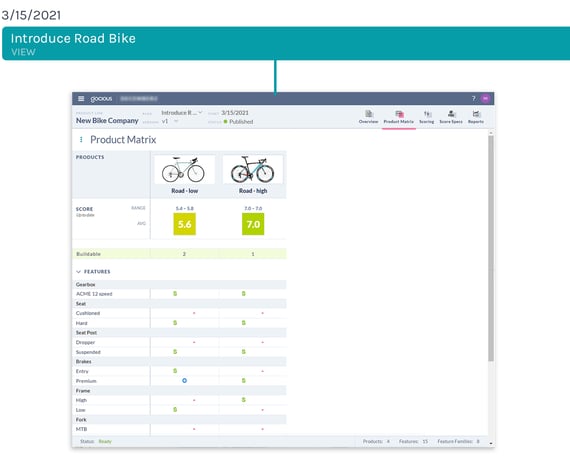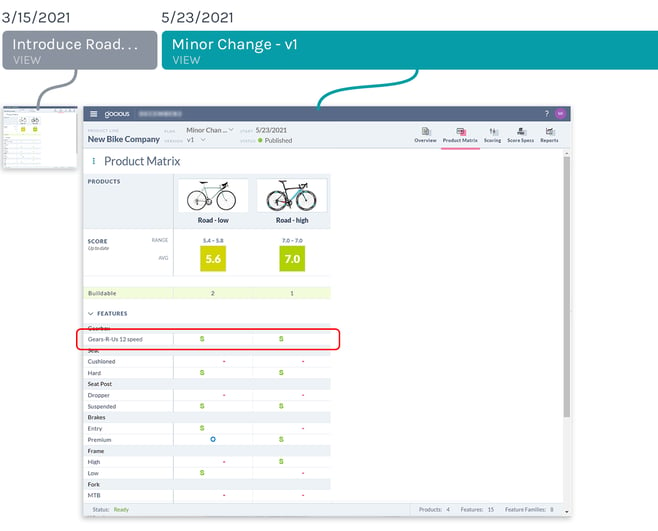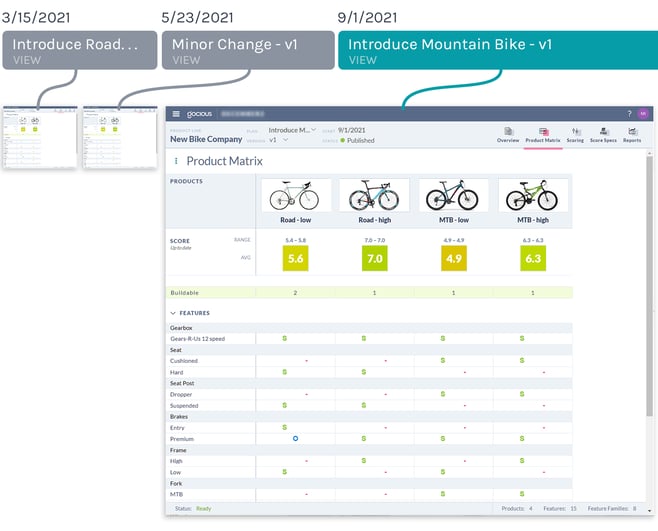There has been a recent change in the market, and you need to analyze your product line and plan a change to the current features and products immediately to address the market in 3 months.
Time is of the essence. You are preparing the introduction of our new product line. The strategy is to release a prototype that includes two products and represents the product line to one region, then expand from there incrementally. Information is coming in daily, which requires adjustments to the product plan. You need to create and share a product roadmap that shows your product line configuration's snapshots at each stage. The configuration includes products and features at each release. You need to adjust the roadmap as you receive new information and communicate the changes back accurately and timely to ensure everyone is on the same page. In the process, you want to find commonality across products to increase reuse, reduce silos, and control complexity when introducing new products.
The product line is a living entity that constantly goes through changes. Some are pre-planned, and some result from reactions to shifting markets and regulations that happen rapidly. As changes in the market are becoming more rapid due to the speed of information flow, product teams need to adjust the plans and communicate them with speed.
Instead of overseeing a single product's roadmap at a time in a disjointed way, manufacturers can benefit from managing the entire product family or product line. Product lines have many interdependencies. Products in a product line share features, and each product cover the needs of a specific segment of the market. Manufacturers can choose to create a broad product line by standardizing features and creating more products or creating a deep product line where they have many options to satisfy the entire market. These are two techniques to meet the customization needs of the market.
Bringing agility into product portfolio planning
Agile planning focuses on value-driven development and enabling organizations to have the flexibility and speed to deliver on them. It shifts the focus to product-based planning. Teams focus on the products and features for the market and the value it provides to the customer. The focus is more on the product structure as opposed to the work structure. This shift in mindset and way of working empowers the team to focus on what is necessary for the market and owning the product's fitness and quality.
The challenge is to have the flexibility to align the organization around one rollout strategy or a shift in strategy on-time to not miss the opportunities or challenges in the market.
Product portfolio roadmap
Unlike a product roadmap, a product portfolio roadmap shows when a collection of products will be introduced in the market. It is a visual way to bring different parts of an organization together around one strategy. Accurate roadmaps that are easily accessible reduce waste in different ways. It reduces unnecessary communication, which saves time. It reduces rework due to misunderstandings. It communicates changes and progression over time, so everyone knows what the increments for a period are and how it fits the bigger picture.
How to create a product portfolio roadmap incrementally
Focusing on products instead of projects, we start by defining the product line and the increments to get to the final product definition. Depending on the strategy, we may want to introduce our products to one market segment and then expand into other segments. For example, you may like to introduce a line for road bikes at two price points and then move to other uses such as mountain bikes to cover the market's needs over time.
We configure snapshots of product lines over time as we plan to make them available. You plan in stages as you receive more information from the past product launches or the market conditions.
You define your product line with the start date of 3/15/2021. You configure features that are offered as standard or optional items on both bikes, sharing most components. You can see the configuration of your product line below.

After initial tests, you realize that you can offer a different gear with improved features from an alternative supplier. You introduce that change starting 5/23/2021. The timeline below shows the change, and the details show the new feature in place for both products.

You then introduce your next products, the mountain bikes. The plan is to start that on 9/1/2021. You enter a new milestone and make changes to the prior plan and add the two new mountain bikes. You can see how your features are shared across all the bikes controlling costs and reducing time to market, as shown in the diagram below.

With the product line roadmap, you can see the changes' timeline and drill down to each event to understand what changes have been made and what does the product line look like starting that event's milestone. Your team will always be in the know and can see exactly when your product line changed and can act accordingly to adjust the orders and manufacturing to support it as a result. It also promotes reuse and commonality across products, which reduces cost and complexity.
How do you plan your portfolio's product and feature roadmap?



